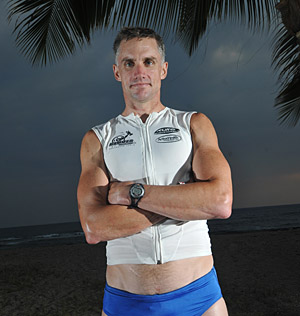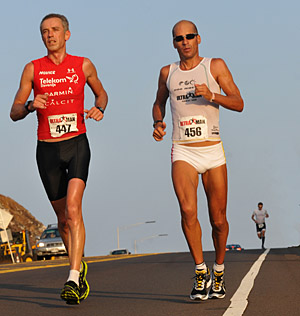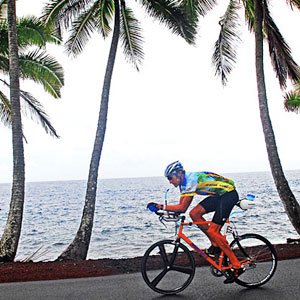The longer, the harder, the better

Triathletes are almost universally familiar with the long, hard road to success at the Ironman traveled by Hall of Famers Mark Allen and Dave Scott, the ungodly number of miles of training and racing embraced by Scott Tinley and Scott Molina, and the pain tolerance and sheer toughness of the likes of Erin Baker and Natascha Badmann.
And yet, there is another level of suffering, distances which dwarf the already daunting Ironman test, to be found in the rarest corners of triathlon. Ultradistance triathletes, and their close cousins ultra-runners and ultradistance cyclists, are far less well known and as a rule receive much smaller – if any – monetary rewards. (the rare exception — ultra-runner Dean Kanarzes, who has achieved mainstream commercial success as an author and motivational speaker chronicling his long distance running feats). But mostly, these are niche races inside a niche sport, contested by athletes who are more likely to qualify for food stamps than prize money. Instead of fame and money, these events offer their very length, difficulty and pain to attract a very select cognoscenti for whom the struggle is its own reward.
This memoir, which covers Erik Seedhouse’s successes and failures in a range of races (not only triathlons), notes his astounding levels of training, but it's far from a how-to training guide. After reading this book, it will be obvious there are no simple recipes for these lengthy endeavors. Instead, they require harnessing obsession and honing focus, patience and pain management into the ability to tiptoe up to the edge of hallucinatory insanity – but not over. Seedhouse applies his scientifically trained mind and precise grasp of language and detail, a self-effacing humor and a curious mind to reveal the motivation that drives him to the limits of human endurance. Without sentimentality, Seedhouse offers a striking reminder of just how nasty and tough these races are to even the most gifted and hard-working athletes.
Norwegian-born Canadian citizen Erik Seedhouse writes that he didn’t always want to make a meager living at little known, mega-painful ultra-distance events. Marathons and a few 100 kilometer tests would have sufficed. Running started well as he posted a 2:39 first marathon with little training at the tender age of 16. After enrolling at Northumbria University in Great Britain to study sports science, he quickly added a 2:25 marathon in London at the age of 19. At that rate of improvement, he dreamed of joining the marathon elites in the Olympics. So when
he was asked to take part with great middle distance runner Steve Cram in a scientific study administered by exercise physiologists, Seedhouse eagerly submitted to VO2, lactate threshold and muscle biopsy tests.

His results would have sent most endurance athletes over the moon – but Seedhouse was crushed when doctors said his VO2 max was “only” 70, a 2:15 marathon was his limit, and, if physiology was destiny, too many slow twitch muscle fibers made his optimum career choice something called ultradistance athlete. Virtually unaware of this obscure sport, Seedhouse sought other roles – North Sea saturation diver (too boring), amateur parachutist (too expensive), astronaut (too late for Canada’s first batch), Royal Navy (failed eyesight test) bodybuilder (passing fancy) French Foreign Legion (a backup plan). All dreams. Until February 1987, when he started the infamous 7-month basic training for the 2nd Battalion, Parachute Regiment of the British Army. A recruiter tried to dissuade Seedhouse, but he thought pain, humiliation, 24/7 exhaustion and relentless physical hell with a 7 percent chance of making the grade was “the sort of attrition rate that appeals to me.”
After enduring the training, Seedhouse served in the jungles of Belize and trained in the desert landscape of Cyprus. Looking back, Seedhouse saw his service as a key reason why he was “able to do so well at ultra-endurance events … because [his military training demanded] pain tolerance and discipline, and the Parachute Regiment instilled those qualities by the bucket load.”
After leaving the Army, Seedhouse saw his marathon improvement curve hit a wall and he took to 100 kilometer road and trail races. From 1989 to 1994, Seedhouse did 20 of those longer races, winning 3 and placing as high as 3rd in the World Championship. He also set a 100km PR of 6:33:03, which he notes was 10th fastest all-time as of 1993.
During this period, Seedhouse picked up a few sponsors, but continued to work a regular job and pursue his Master’s degree while putting in hundreds of kilometers a week in training toward oftimes harrowing race experiences. At the Swiss Alpine Marathon ultra-distance race, Seedhouse encountered a nightmarishly steep downhill section full of loose sharp shale near the end of one stage. “As I rapidly picked up speed, I dodged paramedics stretchering away blood soaked bodies of runners who had impacted the rocks,” he wrote. “I blitzed downward, flying, barely in control, sometimes out of control, arms flailing wildly trying to balance. It was a frightening, exhilarating rollercoaster ride…”
During the 7-day, 700 kilometer Tasmanian Run in 1994, things got worse: “As I fought the howling winds to the finish, the pain assault started. First the bloody urine followed by massive dosages of painkillers. Now I was destroying the skin on my legs by spraying industrial doses of ice spray in a desperate attempt to stem the pain. I had exhausted my countermeasures and was left only with mind games.” At this point, Seedhouse began weaving from side to side on the road and staggered into a guard rail which prevented him from launching off a 300 meter vertical drop.
While the mentally balanced human being would say good riddance when the race was canceled after one edition, Seedhouse writes: “It was a shame… This was the toughest and classiest endurance race on the planet…. All sorts of races lay claim to being the toughest; Badwater 135 (not even close), the Ironman triathlon (not even in the same area code)… Those are all tough races. But they can’t hold a candle to …the Tasmania Run.”

By 1995 Seedhouse targeted ultradistance triathlons as his main ticket to a Red Bull sponsorship – which would enable him to quit his day job as a university lecturer and become a fully professional ultradistance triathlete. His make it or break it test would be the triple Ironman — Le Defi Mondial de l’Endurance, held near Grenoble.
During training in the UK, Seedhouse kept up a 24 hours per week schedule despite wind speeds maxing out at 87 mph, which exacted a death toll of 3 in the area he was riding. The training was good preparation for 336 miles of cycling in near freezing weather and torrential rains that knocked out a quarter of the Defi field. Behind by 2 hours at T2, Seedhouse took the lead with one marathon to go in the 78-mile run leg. Soon thereafter he submitted his resignation to the university and signed a deal with Red Bull and Timex, figuring with prize money and big win performance bonuses, “I would be okay.”
Demonstrating just how precarious his new profession was, he crashed on a downhill on the bike at the Klagenfurt Ironman-distance event, knocking himself out for 20 minutes. Undaunted, he regrouped and won the Double Ironman World Championship in Latvia a few weeks later and earned $2,500. Explaining the dynamics of an ultradistance triathlon pro, he said that race made Red Bull happy, but, as with mountain climbers seeking commercial backing, the pressure was relentless to top previous feats. So he signed up for the infamous Decatriathlon World Championship in Monterrey, Mexico later that fall.
Many draw the line and find the Deca an absurdity – ten times an Ironman – 24 miles of swimming, 1,120 miles of cycling and 262 miles of running. Making it worse, the distances are all completed on a dizzying yet mind-numbing number of short laps in a small park which is suffused with car pollution and noxious fumes from a nearby chemical plant. It is triathlon’s tiny theater of the absurd which reduces the magnificence of the Kona stage to a contest of human tri-hamsters in a polluted sleep deprivation laboratory of exhaustion. Nonetheless, Seedhouse was uniquely prepared and prevailed. With an 18-hour lead on the last day, Seedhouse recalls pulling off by the side of the road, motionless, for an hour: “The media have a field day as race officials encourage me to continue,” he wrote. “Of course I’m going to f*%$#@g continue, I think. I’ve got a f*%$#@g eighteen hour lead! I could crawl to that f*%$#@g finish and still f*%$#@g win.”

The next year, Seedhouse found a much more inspirational triathlon venue and won the three-day Ultraman Triathlon on the Big Island of Hawaii, closing with a then-record 5:57:36 double marathon.
All those miles, training done solo to keep his focus and discipline razor sharp, eventually wore down Seedhouse. At age 35, he decided that the 1999 Race Across America (RAAM) would be his professional farewell. After championship wins at the triple Ironman, the double Ironman, Ultraman and the Deca, Seedhouse determined that RAAM would be the last event he would sell to sponsors. Oddly enough, Seedhouse’s traumatic RAAM experience dramatically underlined what an achievement his previous victories were.
Ignited by exhaustion and the abandonment by 4 members of his support crew two thirds through the race, he suffered a meltdown featuring wild, sleep-deprived hallucinations. When his remaining loyal crew pulls up to ask if he needed some full bike bottles, Seedhouse looked at them dumfounded and asked, “What are you doing here?” Fence posts become people and, in the middle of one desolate night grinding past squashed armadillos on the side of the road, he imagines a blonde girl in a Mercedes SLK 230 drove by and asked what he is doing.
His account of the abandonment by four members of his RAAM crew also illustrates what a crucial role is played by ultra endurance support. Seedhouse and his amazing wife Doina Nugent, an accomplished ultra athlete herself, pulled no punches when describing what they felt was the lazy betrayal of four members of their RAAM crew: “It was impossible to reflect on what had happened and not be enraged,” wrote Doina. “The scumbags had done damn all during the race… [They] were the polar opposite of a support crew should be. They were callous, cold, uncaring and devious to the extreme…. [Near the end], their energies were diverted to seeing how they could get themselves out of the race. They had not one iota of concern about Erik and even tried to bully him into dropping out.”
In an entertaining passage which illustrates that Seedhouse is no saccharine, feel-good author, he describes the emotional state of his two loyal crew members – presumably hyperbolic for comic effect: “Anger and thoughts of revenge occupy the thoughts of Doina and [his brother] Adrian … I know the ‘Bail-Out-Crew’ have escaped lightly. Had Doina had access to a gun at the time, there is no question we would have left four bodies on the side of the road.”
Ultimately, Seedhouse finished 17th and last in 12 days and 6 hours, 3 days and 23 hours behind the winner. The effort signaled the end of his body’s ability to train and perform at the highest level. “RAAM wasn't just the end of my professional career,” he wrote. “It was also the nail in the coffin on my ability to train and race hard. Psychologically, RAAM broke me.”

But it did not break his drive to seek adventure and test his limits– just no longer at world-class, ultradistance race-winning intensity. In 2005 he worked as an astronaut training consultant, studied ways that astronauts might survive a mission to Mars — and was one of the final 30 candidates for the Canadian Space Agency’s Astronaut Recruitment Program. He continued to take on less extreme races as an amateur – finishing 6th in a return to Ultraman in 2008. And despite his reduced ambition, he still faced risks. In 2009, he blacked out while riding in the Ironman 70.3 World Championship in Clearwater, Florida and suffered two pelvic fractures, four broken ribs and a concussion. Four weeks later, he and Doina summited Mt. Kilimanjaro in Africa, part of a quest to climb the tallest mountains on seven continents.
But this dream is proving even tougher than RAAM. Back in 2001, he suffered acute altitude sickness while attempting to summit Mount Aconcagua in South America and almost died. Once again, he was saved by the indomitable Doina, who basically dragged her husband 32 kilometers down the mountain to safety.
Perhaps that sums up the lesson that however lonely it may seem out there, behind every ultra distance explorer of limits is a crucially important, equally committed partner.
Triathlon the Hard Way: Winning the World’s Toughest Triathlons
By Erik Seedhouse
Copyright 2013 — self-published – soft cover
$29.97 – 194 pages
Available from Amazon






